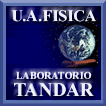|
Resumenes de las Charlas Invitadas
Interlayer coupling and magnetic anisotropies of ferromagnet/semiconductor heterostructures
Laura B. Steren
Centro Atómico and Instituto Balseiro, S.C. de Bariloche, Argentina.
Julian Milano and Ana María Llois
Tandar, Centro Atómico Constituyentes, Buenos Aires, Argentina.
Victor Etgens and Mamoud Eddrief
Université Paris VI-VII, Paris, France.
Abstract
|
The exchange coupling between ferromagnetic layers in metallic multilayers has been a subject of
intense research in the past ten years. The origin and characteristics of the interlayer coupling
have been discussed in a lot of theoretical and experimental articles, but up to now, they are
still open questions. Moreover, structures involving ferromagnetic layers separated by non-magnetic
insulators or semiconductors are presently investigated in order to optimize magnetoresistive
properties of tunnel junctions. Recent articles show that the tunnel magnetoresistance (TMR) not
only depends on the electrodes spin-polarization, as was initially thought, but on the spacer
material and the nature of the interfaces (i.e. roughness, electronic bands). High tunneling
magnetoresistance ratios have been estimated for ferromagnetic metal(FM)/semiconductor(SM)
multilayers, based on electronic bands calculations. However, very low TMR ratios have been
measured in FM/SM/FM tunnel junctions. These results coud be originated in the existence of a
ferromagnetic coupling between the iron layers. Therefore, the understanding of exchange coupling
and other interactions in these heterostructures will also serve to improve its magnetoresistive
properties. Our work is focused on the study of the magnetic coupling and magnetic anisotropies in
FM/SM/FM sandwiches, based on ferromagnetic resonance experiments. This experimental technique is
one of the most developed to study magnetic materials. The dependence of the resonance frequencies
on the energy density function of the sample, provides us with all the essential parameters
describing the magnetic properties of the films.
|
|
